.gif)
originally released in 1973. Some sources refer to "Sniper/Patrol" as a sort of series of games: a similar game by Simulations Publications Inc.
(SPI) was released at the same time as the original Sniper!, called Patrol
.
Sniper! was rereleased in the 1980s in an expanded and improved edition by TSR
. Both games dealt with combat on a man-to-man scale in the Second World War, and the rerelease expanded the scope to include the years 1945-1990, as well as combining material from the original Patrol game also. Three companion games to the 2nd Edition were also released; Hetzer and Special Forces focusing on WWII
and post-1945 combat respectively, and Bug Hunter set in a science-fiction setting.
Initial Release
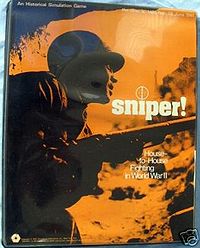
. According to the BoardGameGeek
website, developers included Hank Zucker, John Young, Ed Curran, Bob Felice, Bill Sullivan, Angel Gomez, and Hal Vaughn. Game play focused on urban combat, being subtitled "House to House Fighting in World War Two".
The game was published in three different formats by SPI alone; in a simple white box (a trademark of early SPI games), in a "very" common SPI black box/tray, and a "Designer's Edition" with color box and mounted mapboards.
A set of "footnotes" (actually optional rules) was included, covering such things as sewer movement/combat.
The mapboard was unique in depicting buildings as trapezoids (technically, parallelogram
s, though printed material related to the game usually uses the more general term trapezoid
) - the abstracted shapes allowed for consistency in Line of Sight rules.
The game included 1 34" x 22" Map, 2 Sniper charts and tables, Game Rules, 1 Pad of Simultaneous Movement Sheets, 1 tray with game pieces
, two sets of 2 tanks, two sets of 2 APCs and two sets of 2 trucks as well as 400 die-cut counters in two colors, olive green for Allies and Grey for Germans, with information counters in white. The map itself was in shades of pink/red. The sets of vehicles were printed on cardstock and had to be cut out; they were also trapezoidal in shape.
Second Version
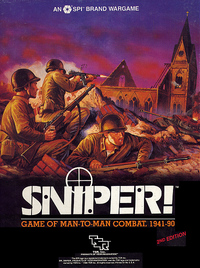
. The game was designed by Steve Winter
, and differed greatly from the original version. The subtitle of the new edition was "Game of Man-to-Man Combat, 1941-90".
The game came in a handsome box (illustrated at right), containing two large 22" x 34" paper maps (double sided, with urban terrain on one side and rural terrain on the other), a 32 page rules booklet, a sheet of vehicle pieces on cardstock (these vehicles were square, however, unlike the original trapezoidal vehicles in the original game), two six-sided dice, a plastic counter tray, and 600 die cut counters.
The maps were identical to each other, allowing for "double-blind" play with an umpire. While one side of the maps depicted urban combat similar to the first Sniper! game, the other depicted rural terrain. The urban map made better use of colour than the original, with grey hexes representing pavement and different sized buildings color coded according to the number of floors they had.
The counters were also very colorful, with soldiers and informational markers in a variety of colours.
The rulebook was divided into Basic, Intermediate, Advanced, and Optional rules.
In an article in Volume 2, Number 6 of Wargamer Magazine (May-June 1988), designer Steve Winter stated:
I find it immensely interesting that when I first started revising the Sniper! and Patrol games in 1985, there were only two other wargames (that I am aware of) that covered modern combat at man-to-man scale. Since then, at least three more have been published (two of which, like the Sniper! game, were based heavily on previously published games). Yet, despite this surge of man-to-man games, very few articles have been published about any of them.
The game used a ground scale of two metres per hex and between thirty seconds and five minutes of time per turn.
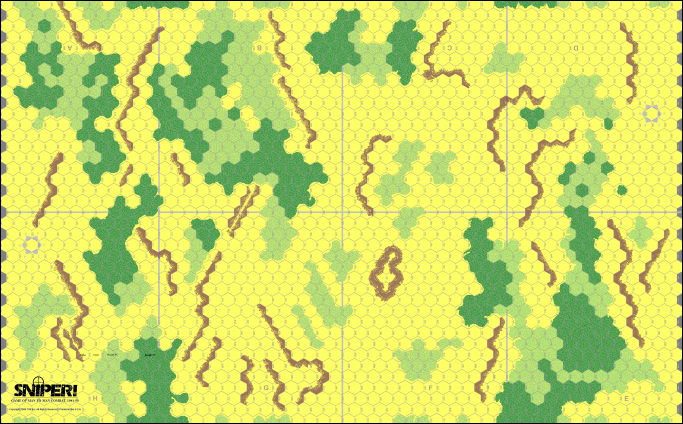
Hetzer
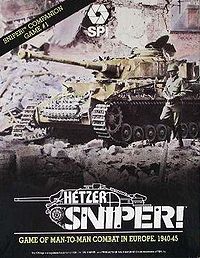
A review by James C. Gordon in Vol 2 Number 5 (Christmas 1988) of The Wargamer Magazine stated the following:
Hetzer...fills a (niche) in the hobby with a challenging view of ground level combat situations in World War II. A player must know his objectives at all times and keep a clear plan in mind. Managing forces of sometimes questionable reliability, weapons systems with various strengths and weaknesses, and reacting to the opposition requires the skills of a chess player. Overly aggressive play can lead to excessive and unnecessary casualties. A passive defense leaves the player vulnerable to the impact of the opponent's plans.
Physical Quality: Professionally done map and counters. The rules are well organized.
Playability: Lots to remember and lots to do, but the system is not cumbersome. Some record keeping involved.
Historicity: Derives from the technical details, "typical" situations and objectives. Good marks for all.
Comparison: Ambush!
Ambush!Ambush! is a man-to-man wargame developed by Avalon Hill. It was released under Avalon's Victory Games label and was developed by Eric Lee Smith and John Butterfield. In 1984, Ambush! won the Origins Award for Best 20th Century Boardgame of 1983...
is similar, although solitaire. Trenchfoot covers a different era but at the same level. The original Sniper! had Patrol as a companion.
Special Forces
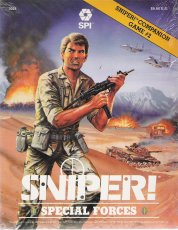
Summary
Special Forces, billed as "Sniper! Companion Game #2" was sold in a magazine-type format, with a hard cover folded over loose contents, including two 21" x 32" maps, a 24 page rulebook, a second 16 page rule book, an 8 page scenario booklet, a reference card, a ziploc bag and 400 die-cut counters. This too was a standalone product, designed by Rick Swan, though the format allowed it to be offered for a reduced price.
Swan provided an extended set of Designer's Notes in Volume 2, Number 6 of Wargamer Magazine (May-June 1988).
I was more or less given a free hand to set the scope of the game, so the first design decision was to establish parameters. It seemed it could go one of two ways - it could either focus on a few select forces in specifically chosen conflicts, or it could take a broader view and allow for forces from around the world to participate in a variety of situations. The first option would demand a more detailed and complicated system than I wanted, not to mention requiring the answers to questions I wasn't comfortable answering (Which nationalities should be included? What's a "typical" terrorist operation?). The second option was more attractive - not only would it give players a lot to pick from, it sounded like it'd be more fun to design and more like a game I'd like to play.
Terry Rooker, writing in Fire and Movement Magazine Number 73, May/June 1991, had the following comments on the suitability of the game system to the subject material ostensibly covered by Special Forces:
Despite its potential, Sniper! (emphasis in original) is lacking. It has many of the pieces, but it fails to capture some of the most important aspects of LIC (Light Infantry combat). Part of (the) problem is one of scale. Platoon and squad sized units are not committed until the intelligence people have a good idea about what is going on. Much of the guesswork and uncertainty is missing. Part of the problem is the system. The original system was designed for WWII infantry engagements. In that type of warfare, everyone obeys the rules of land warfare and wears a uniform of the appropriate color. In LIC situations, the situation is not so clear. The combatants often wear clothing indistinguishable from the non-combatants. Target identification is much more difficult....For the direct action part of a mission (however), Sniper! Special Forces is the best game available.
Bug Hunter
"Sniper!" Companion Game #3" was a futuristic version of Sniper!, called Bug Hunter, focusing on "the popular science fiction theme of embattled humans threatened by vicious alien creatures in space and on the ground" as described in Volume 2, Number 6 of Wargamer Magazine (May-June 1988).According to the BoardGameGeek site:
Bug Hunter is a Sniper!/Patrol! series game about hypothetical clashes between spacefaring human adventurers and hostile alien monsters.
As in all games in the Sniper! series, this game focuses on combat as experienced by the individual soldier. This game examines the problems and situations peculiar to close combat in strange environments and against unknown foes.
Multiple geomorphic 2-sided maps are included in the game to play out numerous scenarios (for from 1 to 3 players), each with their own set of victory conditions. The game also includes rules to Sniper!, exclusive Bug Hunter rules, scenario booklet, random event cards, cut out vehicles, and 400 personnel counters and markers.
The geomorphic maps could be combined into two large maps, identical in size and shape to the original Sniper! maps, depicting indoor space stations, again using familiar trapezoidal architectural structures. The same rigid book-cover format as used in Special Forces was used for this release.
Game Features in Common
All four of the published games were quick to set up and to play, with varying degrees of complexity depending on the rules used. Some unique design features included the use of trapezoidal building depictions on the maps, to better simulate lines of sight, and the use of multi-hex counters (in actuality, thin card stock) to simulate vehicles. At a map scale of 2 metres per hex, some vehicles occupied as many as 8 hexes simultaneously.Computer Versions
A version of this game was released for Compuservein the late 1980s. Paul C. Schuytema reviewed the Sniper!
computer game in the January 1993 issue of Compute! (Issue 148):
CompuServe offers SNIPER!, a European-theater, squad-level, World War II war game. The game can be played in ASCII, but the text characters are far too cryptic for my tastes. What makes this game shine is the graphical shell which you can down-load (there's no connect-time fee but there is a $2 flat fee for the software).
The software gives the player a skewed 3-D view of the battlefields (including building interiors), as well as several information windows displaying the status of the game.
While the game's control logistics seem a little obtuse at first, you can enter a modified boot camp where you explore all of the various commands. Battles are arranged in the game's meeting area, called the saloon. The games are actually missions with set goals for each side.
The game given a positive review in Computer Gaming World
, admiring it both as a social experience as well as a competitive game.
A VASSAL version of both the original Sniper! and Patrol games, as well as the 2nd Edition game and companions, is being developed.http://www.vassalengine.org/community/index.php

